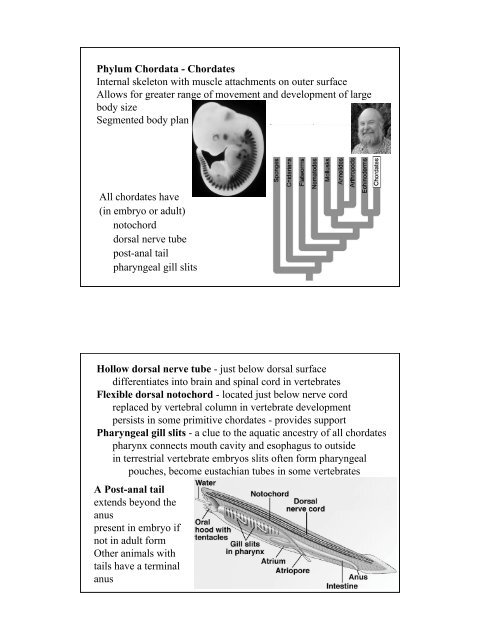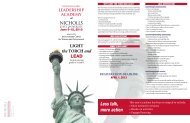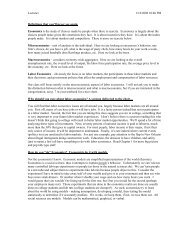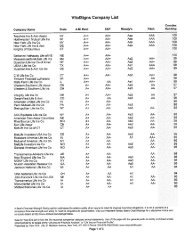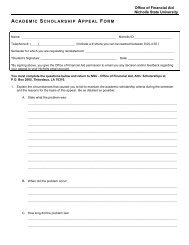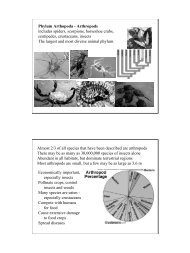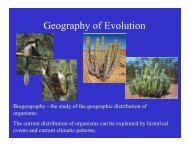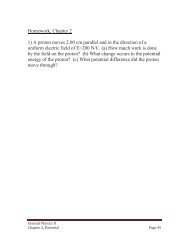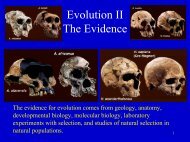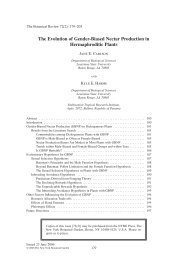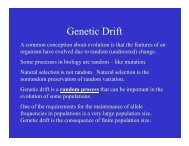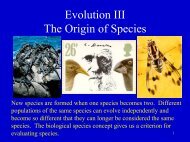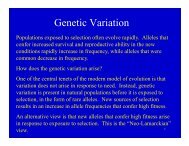Phylum Chordata - Chordates Internal skeleton with muscle ...
Phylum Chordata - Chordates Internal skeleton with muscle ...
Phylum Chordata - Chordates Internal skeleton with muscle ...
You also want an ePaper? Increase the reach of your titles
YUMPU automatically turns print PDFs into web optimized ePapers that Google loves.
The defining chordate characteristics are preserved in the adultlanceletSubphylum Vertebrata - VertebratesAll vertebrates have a distinct head, <strong>with</strong> skull enclosing a brainName derived from bony vertebral segments in spinal columnVertebral column - protects dorsal nerve cordnotochord surrounded and replaced by vertebral columnPossess a cranium - brain caseGroup also called craniate chordatesMost have a bony <strong>skeleton</strong>, some use only cartilageAll have a closed circulatory system
The vertebralcentra replacethe notochordNeural spinesdevelop tosurround andprotect theneural tubebehind the headAll vertebrates also have a unique set of cells that originateabove the neural tube during development - “neural crest cells”Neural crest cells migrate throughout vertebrate body andcontribute to the development of many organsBrief overview of vertebrate evolutionFirst vertebrates were marine, lacking jaws or paired fins (550 mya)Jawed fishes then became dominant creatures in the sea (450 mya)Amphibian ancestors first to invade the land (400 mya)Largely replaced by reptiles more suited to live on land (300 mya)Dinosaurs and other reptiles ruled the earth for 150 million yearstheir extinction (65 mya) allowed mammals to become dominantMost livingvertebrate groupshave diversifiedgreatly since theirorigin.
The vertebrates are composed of eight classesFour classes are aquatic fishesClass Myxini - HagfishClass Cephalaspidomorphi - LampreysClass Chondrichthyes - Sharks, skates and raysClass Osteichthyes - Bony fishesFour classes are terrestrial tetrapodsClass Amphibia - Salamanders, frogs and toadsClass Reptilia - ReptilesClass Aves - BirdsClass Mammalia - MammalsCharacteristics of FishesGills - extract dissolved oxygen from water around themwater passes over filaments rich in blood vesselsblood moves opposite the flow of water - an efficient systemVertebral column<strong>Internal</strong> <strong>skeleton</strong> <strong>with</strong> spine surrounding dorsal nerve cordSkeleton may be made of cartilage or boneBrain fully encased in protective skull
Single-loop blood circulationBlood pumped from heart to gillsOxygenated blood from gills passes to rest of bodyHeart is series of fourchambers thatcontract insequenceNutritional deficienciesAll vertebrates are unable to synthesize aromatic amino acidsAll must consume these amino acids in their dietOverview of Fish EvolutionFirst fishes known were jawless <strong>with</strong> heavy bony armor<strong>Internal</strong> <strong>skeleton</strong> was made of cartilageSurvived by lampreys and hagfish (“Agnathans” - no jaws)First jawed fishes occurred 410 million years agoEarly jawed fisheswere replaced bymore agile sharksand bony fishes
Sharks became dominant predators about 300 myaClass Chondrichthyes - sharks, skates, raysSkeleton is made of cartilageHave bony teeth and scales <strong>with</strong> enamelHave always been large agile predatorsenlarged pectoral fins allow greater lift andmaneuvering during swimmingHave internal fertilizationyoung are well-developed when bornskates and rays have flattened bodies andare more sedentaryClass Osteichthyes - bony fishesEvolved at same time as sharks, but in freshwaterDeveloped heavy <strong>skeleton</strong> made completely of boneOssification replaces cartilage <strong>with</strong> boneExternal plates and scales also made of boneAdded swim bladder for respiration/buoyancyPrimitive fishes use swimbladder for respiration - a lungModern fishes use swimbladder for buoyancy
Modern bony fishes have highly mobile fins, thin scales andsymmetrical tailsThey are an extremely successful group and are dominant infreshwater and the seaTwo lineages of bony fishes evolvedRay-finned fishes - most modern fish<strong>Internal</strong> <strong>skeleton</strong> of bony rays supportsand stiffens each finNo <strong>muscle</strong>s <strong>with</strong>in finsSwim bladder used for buoyancyLobe-finned fishes - 6 living species5 lungfishes, and the “coelacanth”have fins <strong>with</strong> muscular lobesswim bladder used for respirationearly form gave rise to amphibiansImportant characteristics of bony fishesLateral line systemSeries of small sensory organs that project into a canal beneathskin surface - sensitive to water pressure changesallows fish to sense movements in waterSimilar structures found in all vertebrate ears - for hearingGill coverHard plate covering gills called the operculumHelps to pump water over gills even when stationary
Class Amphibia - Amphibiansincludes frogs, salamanders, caeciliansAmphibians were the first “tetrapods”the first terrestrial vertebratesThere are three orders of AmphibiansOrder Anura - frogs and toadsOrder Urodela - salamandersOrder Apoda - caeciliansCharacteristics of AmphibiansLegs - a key adaptation for terrestrial livingFrog and salamanders have two pairs, lost in caeciliansLungs - a modified swim bladder used for terrestrial respirationswallow air by moving floor of mouthCutaneous respiration - gas exchange at skinsupplement lung respiration <strong>with</strong> a highly vascularized skinMoist skin provides extensive surface area, limits body size
Pulmonary veinsVeins return blood from lungs to heartAerated blood leaves heart at greaterpressure than it leaves lungsPartially divided heartpartially separated pulmonary and systemic pathwaysimperfect since there is a single ventricle where oxygenatedand deoxygenated blood can mixOrigin of Amphibiansevolved from lobe-finnedfishes - skeletal structureof lobe-finned fishes andearly amphibians is verysimilarEarliest amphibianfossil, Ichthyostegabuilt for terrestrial life<strong>with</strong> lungs and a stronglegs and backboneMost amphibians still must lay their eggs in water to keep themfrom drying outBecause of moist skin, adults are also liable to become dehydrated
Modern AmphibiansOrder Anura - frogs and toads - tailless amphibiansFrogs have smooth, moist skin; long legs; live in or near waterToads have bumpy, dry skin; short legs; are adapted to dryenvironmentsAll are carnivores, eat a wide variety of invertebratesMost return to water to reproduceEggs lack water-tight membranes and dry out readilyEggs fertilized externallyEggs hatch into algae-eating, swimming larval tadpolesTadpoles metamorphose into adultsOrder Urodela - salamanders - amphibians <strong>with</strong> tailsHave elongated bodies, long tails and smooth moist skinLive in moist places, some live entirely in waterLay eggs in water or moist areasFertilization is external in most speciesJuveniles look like adults, do not undergo major metamorphosisOrder Apoda - caecilians - legless amphibiansHighly specialized group of burrowing amphibiansLack legs, have small eyes, are often blindEat worms and soil invertebratesMale deposits sperm directly into femaleyoung are born alive
Class Reptilia - Reptilesincludes turtles, lizards, snakes, alligatorsReptile improvements on the amphibian planLeg design allows better body supportLungs and heart are more efficientDry skin covered <strong>with</strong> scalesWater-tight eggsKey Characteristics of ReptilesAmniotic egg - Water-tight eggs contain food source (yolk) andfour membranes: Chorion, amnion, yolk sac and allantoisEach important an embryonic life-support systemChorion allows oxygen to enter, but retains waterAmnion encases developing embryo <strong>with</strong>in fluid-filled cavityYolk sac holds food for embryo - extracted by blood vesselsAllantois encloses waste products
Dry skin <strong>with</strong> scales or armor reduces water lossScales develop as surface cells fill <strong>with</strong> protein keratinKeratin is also used for mammal hair and bird feathersThoracic breathing - increase volume of air inspiredExpand and contract rib cage to suck air in and force it outCapacity limited only by volume of lungsImproved leg design -legs placed moreventrally under trunkallows better support ofthe body and greatermobilityallows larger body sizeReptile Evolution - Reptiles were the dominant land animals for250 myFour major lineages evolved in series: Pelycosaurs, Therapsids,Thecodonts, DinosaursPelycosaurs - improved predatorssynapsid skull <strong>with</strong> temporal openings allowedbetter <strong>muscle</strong> attachment and more powerful biteDominant terrestrial vertebratesfor 50 million yearsReplaced by Therapsids
Therapsids - Mammal-like reptileshad higher food intake, and probably had higher metabolic ratespeculated that these were the first endothermic (“warmblooded”)vertebrates - likely evolved in cooler climatedominant terrestrial vertebrates for 20 million yearsTherapsids were the ancestors of mammalsReplaced by Thecodont reptiles - a different lineageThey may havehad hair, liketheir mammaldescendantsThecodonts - greater energy efficiencyWere “cold-blooded” ectotherms like amphibians and early reptilesenvironmental change resulted in warmer temperaturesendothermy requires less energy intake for body maintenanceHad an improved skull - diapsid -Diapsid reptiles, had two pairs of temporal holes in skullFirst land vertebrates to walk on hind limbs onlyDominant for 15 myReplaced by their directdescendants, Dinosaurs
Dinosaurs - greater agilityLegs positioned directly underneath body - allowed larger bodyEnabled running <strong>with</strong> speed and agilityDominated land for 150 million yearsWent extinct 65 million years ago - likely due to asteroid impactOverview of the evolution of “amniotes” - reptiles, birds,mammals, and their ancestors
Modern Reptiles - Four surviving ordersTurtles - ancient survivorsHave changed little since before time of dinosaursHave solid skulls (no temporal openings) like first reptilesHave changed little since before time of dinosaursLizards and snakes - most modern reptiles are in this groupAlso evolved very early - 250 myaDiversified after disappearance of dinosaursTuataras - a remnant of a groupthat was once commonOnly two species survive onislands near New ZealandSmall, sluggish, diapsid reptiles,Common in Jurassic, declined inCretaceousUnable to compete <strong>with</strong> lizards,in most environmentsCrocodiles - the most derived “reptiles”Descended from same line that produced dinosaursLittle changed in the last 200 million years but <strong>with</strong> advancedcharacteristics they share <strong>with</strong> birdsparental care, four-chambered heart,vocalizations for mate attractionCrocodiles and birds more closely related to dinosaurs and eachother than they are related to lizards and snakesCrocodiles, Thecodonts, Dinosaurs, and Birds form amonophyletic group - the Archosaurs
Other Important Characteristics of Reptiles<strong>Internal</strong> fertilization - a requirement <strong>with</strong> a shelled eggImproved circulatory system - Circulatory system provides moreoxygen to bodySeptum in heart extended fromatrium partway into ventricleDecreases mixing ofoxygenated and deoxygenatedSeptum totally divides ventriclein crocodiles and birds (a fourchamberedheart)All living reptiles are ectothermic, obtain heat from externalsources - regulate body temperature through behaviors - baskingor seeking shadeOrder Chelonia - Turtles and tortoisesTurtles generally live in water, tortoises live on landBodies are encased in a protective shellCarapace covers dorsal surfacePlastron covers ventral portionVertebrae and ribs fused <strong>with</strong> carapaceLack teeth, but have sharp beakOrder Rhynchocephalia - TuatarasTwo species makes up entire orderfound only on islands of New ZealandHas spiny crest running down backHas inconspicuous parietal or “third eye” on top of headhas lens, retina and is connected to brainMay function as a thermostat, protect it from overheating
Order Squamata - Lizards and snakesMales have paired copulatory organslower jaw not joined directly to skullallows flexibility in jaw movementsmost are predatory carnivoresLizards have limbs, snakes do notSnakes lack movable eyelids andexternal ears - can’t hearLizards are more ancient groupLizards rely on agility and speedto catch prey and avoidpredatorsMost snakes depend on stealthMany lizards can loose tail toescape predator andregenerate new oneOrder Crocodilia - Crocodiles and AlligatorsPrimitive-looking reptiles also includes caimans and gavialsSimilar to 200 million year old fossil formsLive in or near water in tropical or subtropical regionsAre aggressive carnivores, bodies adapted for hunting by stealthEyes and nostrils on top of head, lie submerged in waterEnormous mouths <strong>with</strong> sharp teeth and strong neckCan feed underwater, valve prevents water from entering airpassageThe only living reptiles that care for their young
Class Aves - BirdsMost successful of all terrestrial vertebratesgreat diversity, 8800 speciesKey Characteristics of BirdsProduce amniotic eggs - like reptilesHave keratin scales on feet and legs - like reptilesLack teeth - developmental mutants have reptile-like teethHave very small tail - unlike reptilesFeathersModified reptilian scalesProvide lift for flight and insulateDevelop from folliclesHas shaft, <strong>with</strong> barbs, <strong>with</strong>barbules, <strong>with</strong> interlocking hooksFlexible, light-weight, and strongCan be replaced, like scalesFlight <strong>skeleton</strong>Bird bones are thin, hollow,and light-weightMany have internal struts tostrengthen the bone <strong>with</strong>little added weightMany bones are fused toeach other - reducesnumberHave fused collarbones(wishbone) for recoil ofwings during flightHave keeled breastbone - forattachment of flight<strong>muscle</strong>s
The Evolution of BirdsArchaeopteryx, the first bird - fossils date to 150 myaShares features <strong>with</strong> small therapod dinosaursSkull has teethVery few bones are fused to each otherBones are solid (bird bones are hollow)Has long reptilian tailHas no breastboneConsidered a bird because of feathers on wings and tailModern BirdsBeak and feet characterize many bird habitsHave unique physiology to cope <strong>with</strong> high energy demands of flightEfficient respiration - “flow-through lungs”Gas flows throughlungs in only onedirection and oppositedirection of blood flow- an efficient systemNo “dead-air” in birdlungs
Efficient circulationHas four-chambered heart -like mammals butindependently evolvedWall dividing ventricle iscomplete, two circulationsdo not mixFlight <strong>muscle</strong>s get fullyoxygenated bloodEndothermyBirds maintain higher body temperatures than most mammalsMetabolism in flight <strong>muscle</strong>s proceeds at faster rateFeathers provide insulation to conserve heatClass Mammalia - MammalsThe least diverse group of vertebrates -4100 speciesAlmost all large land vertebrates are mammalsMost mammals are not large3200 species are rodents, bats, shrews, molesGreatest diversity was reached about 15 myanumbers are declining due to relativelycool climate
Key Mammalian CharacteristicsHairHelps regulate body temperature, allows life in colder climatesNot derived from reptilian scales or feathersEach hair extends like stiff thread from bulb-like hair follicleComposed of dead cells filled <strong>with</strong> fibrous keratin proteinInsulates against heat lossProvides camouflageWhiskers function as sensory structuresServe as defensive weapons as in porcupines and hedgehogsMilk-producing glandsAll mammals have mammary glands that produce milkMammary glands are modified sweat glandsMilk is rich in fat, sugar, protein <strong>with</strong> 95% waterHigh calorie food needed to support rapid growth of newbornEvolution of MammalsArose from Therapsids in Triassic, 220 myaFirst mammals were small insectivoresHad large eyes - they may have been nocturnalMammal jaw reduced to massive bone <strong>with</strong> a single jointAllows strong biteTwo jaw bones moved to middle ear to make three bone chainthat improved hearing - malleus, incus, stapesWere a minor group until the Cretaceous (65 mya)Two groups - Prototheria and TheriaPrototheria - egg-laying mammalsclose relatives of therapsidsSmall, resembled modern shrewsTheria - live-bearing mammalsSubdivided into marsupials (pouched mammals) andplacental mammals
Characteristics of Modern MammalsEndothermyAllows activity in cooler weather and times of dayAllows colonization of harsh environments, deserts to arcticHair provides insulation to support endothermyHigher metabolic rate required as wellEfficient circulationprovided by four chambered heartImproved respirationDiaphragm breathing <strong>muscle</strong> allowsgreater volume of air to be inspiredPlacentaMost mammals are placental and viviparous (live bearing)Blood stream of mother and fetus in close contact at placentaFood, water, oxygen pass from mother to childWastes pass from child to mother, carried away
TeethReptiles have homodont dentition - all teeth are the sameMammal dentition is heterodont - variation in teeth in mouthHighly specialized to match food eatenMammals as a group eat a wide variety of foods but individualspecies often have highly specialized feedingDigestive systems for eating plantsMost mammals are herbivores<strong>with</strong> help of symbiotic bacteria cellulose is major foodSome mammals have four-chambered stomachsfirst chamber is large, holds most cellulose-digesting bacteriaPartially digested plants are regurgitated (cud) and chewedSwallowed again and digested by succeeding stomachsthen passes to intestineOther mammals digest plant material in the large intestineHave relatively small stomachs, do not chew a cudBacteria live in pouch called the caecum, off the large intestineHerbivores must eat great mass to gain sufficient nutrition
Hooves, Horns, and Antlersclaws, fingernails, hair, and hooves are made of keratinHooves cushion and protect toes in running mammalsHorns have a core of bone surrounded by keratin sheathnot shed, bony core is attached to skullOuter layer is compacted hair-like layersAntlers are made only of boneMale deer grow and shed a set of antlers each yearCovered by thin skin layer of velvet while growingVelvet dies and is scraped off when antlers are fully grownAntlers used to combat rival males in fall and winterShed in spring after breeding seasonRhinoceros horn composed of keratinized hairFlightBats are only mammals capable of powered flightWings are modified forelimbsleathery membrane of skin stretched over bones of four fingersedges attach to side of body and to hind legBats at rest hang upside down from legsHave sonar system tonavigate in dark andfind insectsHigh frequency pulsesemitted through mouthor noseSound waves reflect offobjects, captured bylarge ears
Modern Mammalsnineteen ordersSeventeen are placental mammalsTwo are non-placental mammals :monotremes and marsupialsMonotremes - Egg-laying mammalsIncludes duck-billed platypus and two species of echidnaMonotremes retain some reptilian characteristicsLay shelled eggs which they incubate in a nestShoulder and pelvic bones similar to early reptilesHave a cloaca - a single opening for feces, urine, and eggsMore closely related to early extinct mammalsHave functioning mammary glandsMarsupials - Pouched-mammalsMarsupial fertilized egg is amniotic but lacks shellMarsupial egg has much yolk to nourish embryoEmbryonic marsupial is born early in developmentCrawls to marsupial pouch, attaches to nipple, continues todevelop for monthsNearly all modern marsupials live inAustralia and New GuineaOnly 20 of 280 total species liveelsewhereMarsupials in Australia and NewGuinea fill niches that placentalmammals fill elsewhereVirginia opossum is the only marsupialin North America
Placental mammalsHave well-developed placentathat nourishes embryosfor entire developmentEggs have little yolkPlacenta forms early in courseof developmentEmbryos develop in uterus (womb)of motherFetal placenta formed fromchorion and allantoisMaternal placenta formed fromwall of uterusYoung undergo considerabledevelopment before birthMany have extensive parental care


